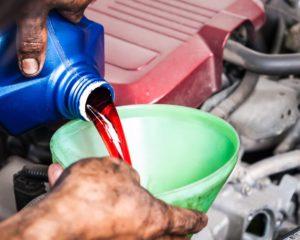Your car’s transmission needs fluid just like its engine needs oil. Transmission fluid lubricates the metal parts, making sure that everything runs smoothly and nothing overheats. Most people know that not enough transmission is a bad thing, but too much transmission fluid can be, too.
Have you noticed changes in how your car performs or heard noises coming from under the hood? Too much transmission fluid could be to blame. Here’s how you know if you put too much transmission fluid in your car and what could go wrong as a result.
What Happens If You Overfill Your Transmission?
From engine oil and brake fluid to transmission fluid and coolant, your car relies on multiple fluids to operate smoothly. Every car manufacturer has specific recommendations for how much of each oil or fluid to use, and if you use too much, many things can go wrong.
Transmission oil lubricates the surfaces in the transmission to prevent friction, stopping premature wear and other damage. But you need to use the right amount of fluid. Why? Because using the right amount of fluid maintains the correct amount of pressure inside the transmission. Too much fluid results in too much pressure, which can cause multiple problems, including:
The fluid becomes contaminated with air
When there’s too much pressure in the transmission, the gears splash the fluid inside the chamber, causing foam and air bubbles to form. These bubbles affect how well the fluid can lubricate the transmission. Instead of a thin layer of oil lubricating the metal parts, the layer is filled with bubbles, meaning that air and not fluid circulates the transmission. Some areas do not receive any lubrication at all, and the metal parts grind together.
Metal-on-metal is never good. It leads to premature wear, permanent damage, and makes it difficult to shift gears.
The transmission can overheat
One of the main functions of transmission oil is to prevent overheating by keeping things running smoothly, eliminating friction. Friction causes heat, so when metal surfaces rub together, it raises the temperature inside the transmission.
Overheating doesn’t immediately cause damage. But it can over time, causing the seals to break down. The fluid will leak out of the gearbox and you won’t be able to shift gears when driving.
The transmission can fail
Eventually, the increased fluid pressure, damaged seals, and leaking fluid lead to a lot of damage. The metal parts keep rubbing together and, in time, the transmission will fail. You can get a new one, but this is a costly repair.
Signs of Too Much Transmission Fluid
Now that you know what happens if your car has too much transmission fluid, let’s take a look at some of the signs you should keep an eye out for.
Dipstick Indicates Too Much Transmission Fluid
Although it is somewhat unreliable, checking the dip stick is the easiest way to determine if you have too much transmission fluid in your gearbox. All you have to do is pull the dipstick out and take a look at where the fill line is.
The transmission dipstick method is not the most accurate way to go to determine excess fluid, but it will do in a pinch. Many factors can make the reading inaccurate, though, including the temperature of the fluid or fluid sticking to the sides of the port. Tranny fluid thickens when it’s cold and thins as it heats, so make sure you let the engine cool for a while before checking the fluid level this way to get the best results.
Difficulty Shifting Gears
If you have difficulty shifting gears, your transmission fluid might have too little or too much fluid. As mentioned, when the problem is too much fluid, the increased pressure leads to bubbles, which affects how well the transmission fluid lubricates the metal pieces.
You may also notice difficulty shifting gears if the transmission overheats due to too much fluid. Again, this eventually damages the seals, which eventually leads to not having enough fluid.
Leaking Fluid
Leaking fluid is one of the main signs that your transmission is overfilled. Cars have lots of fluids in them, but it’s easy to tell when you see transmission fluid because it’s usually orange, pink, or red.
Noises Coming from Under the Hood
Noises coming from under the hood are usually very hard to diagnose, especially since the transmission is so close to the engine. Many car owners don’t pick up on transmission noises, but if you know what to listen for, you might get lucky.
If you hear whining coming from the transmission, it’s likely an indication that there’s a problem with the transmission fluid pump. Humming can also indicate excess fluid, and grinding can mean that the gears are already rubbing against one another, causing damage.
How to Fix It
There are two ways to extract extra transmission fluid.
Siphon It Off the Top
Although this is not an exact science, siphoning extra transmission fluid from the top gives you a little more control over how much you’re removing.
Here’s how to do it:
- Before you begin, make sure the engine has been cooling for at least 15 minutes.
- Get an inexpensive transfer pump, like this one from Koehler Enterprises.
- Get a container large enough to hold the pump and the hose.
- Insert the end of the hose into the dipstick hole.
- Use the pump handle to extract some fluid.
- Go for a drive for at least 20 minutes to heat the fluid.
- When you get back, check the level without allowing the engine to cool.
This method is not precise as you don’t know exactly how much fluid you’re removing, but it gives you a lot more control over how much you’re taking out than the next method.
Drain It from the Bottom
This method isn’t preferred, but it is an option. Because you’re releasing the drain plug, you have gravity working against you. That is to say that the fluid will drain out on its own when you remove the plug, so you may remove too much.
Another thing about this method that’s not ideal is that you have to access the undercarriage to do it. Most people don’t have access to a mechanic’s lift or trench, so you’ll need to get car stands or a jack.
Once you have the car elevated and can get underneath it, here’s what you do:
- Let the car cool completely before you get started.
- Use a socket wrench to loosen the plug, but don’t remove it yet.
- Put a drain pan under the drain, then loosen the plug until it’s just about to come out.
- Remove the plug, but make sure you hold it close to the drain so that you can quickly seal it up again when needed.
- Once you let out a little fluid, seal the drain and lower the car.
- Take a 15 to 20-minute drive to warm up the fluid. When you get back, check the fluid using the dipstick before the engine cools.
If you don’t remove enough fluid, you’ll have to repeat the whole process. Make sure you let the engine cool before removing more fluid. If you don’t, it may be too hot and you may burn yourself when holding your hand under the fluid to reinsert the plug.
Final Thoughts
Any time you hear noises coming from under the hood, it’s important to get it checked out. If you’re hearing a whining, humming, or grinding coming from your transmission, too much fluid may be the problem.
Many people don’t realize that too much transmission fluid can be a very bad thing. It increases the pressure in the transmission, which can lead to air bubbles that affect lubrication and overheating. Overheating can then damage the seals, causing the fluid to leak.
Eventually, too much or too little fluid leads to the metal components grinding against each other. At the very least, this causes premature wear and tear, but it can also lead to transmission failure.
Removing some transmission fluid is a pretty straightforward fix. Although the methods outlined above aren’t exact, they can get you through until you can see your mechanic and can save you from more extensive damage and costly repairs.

